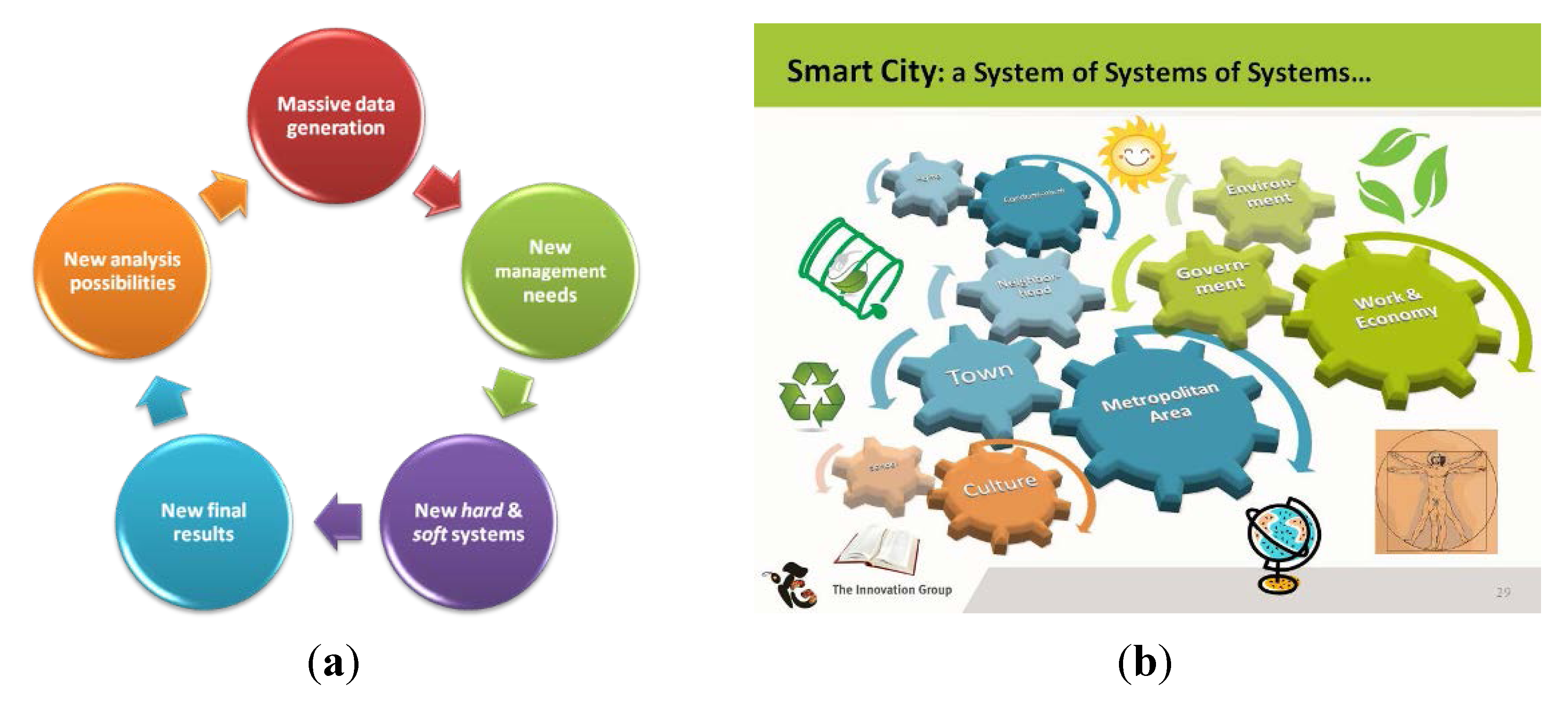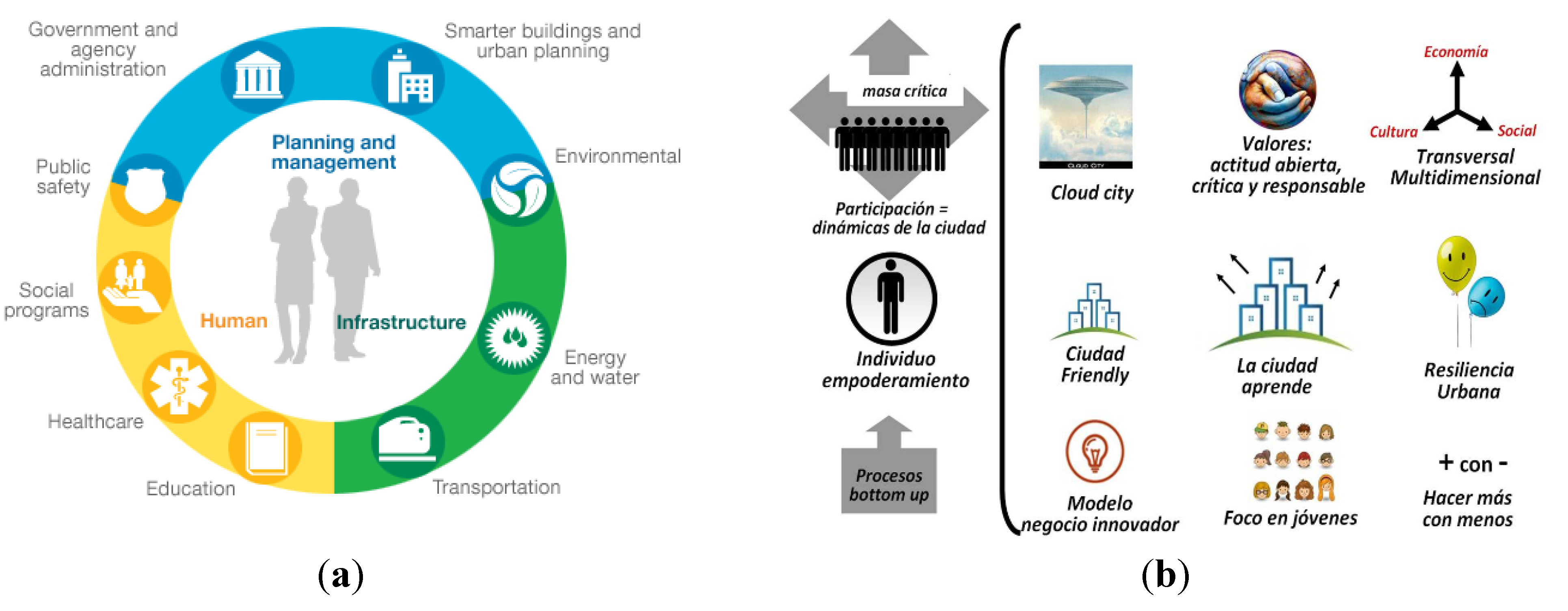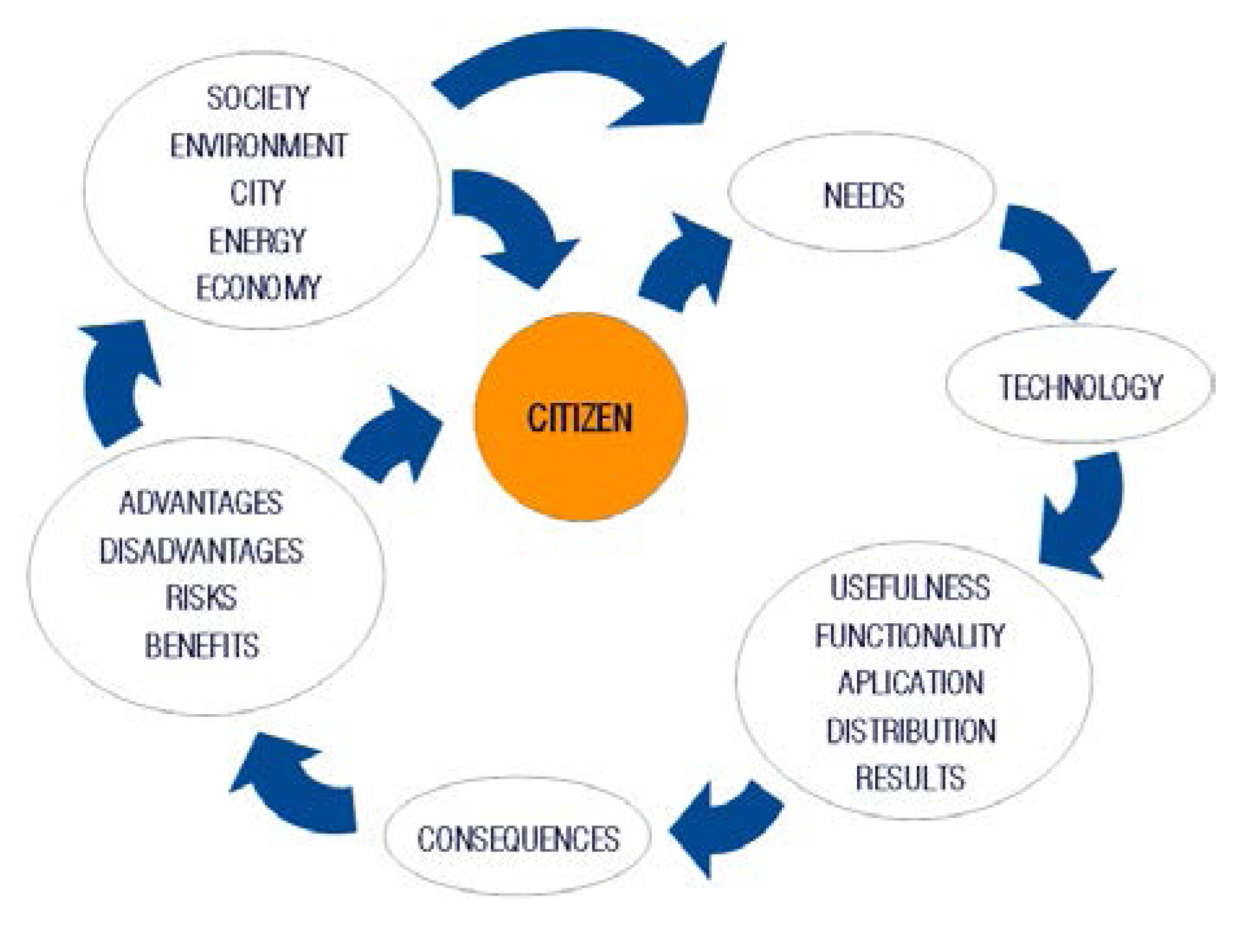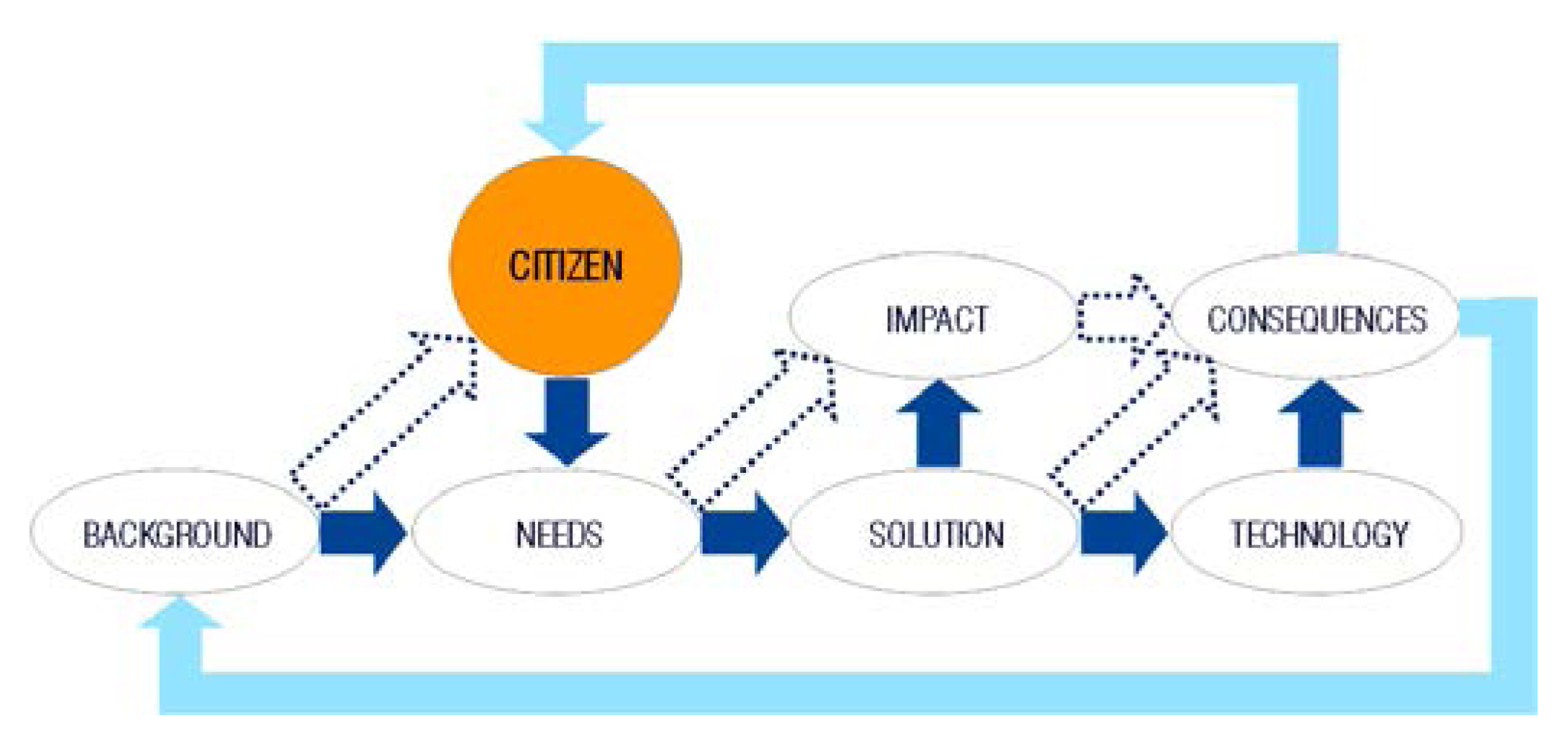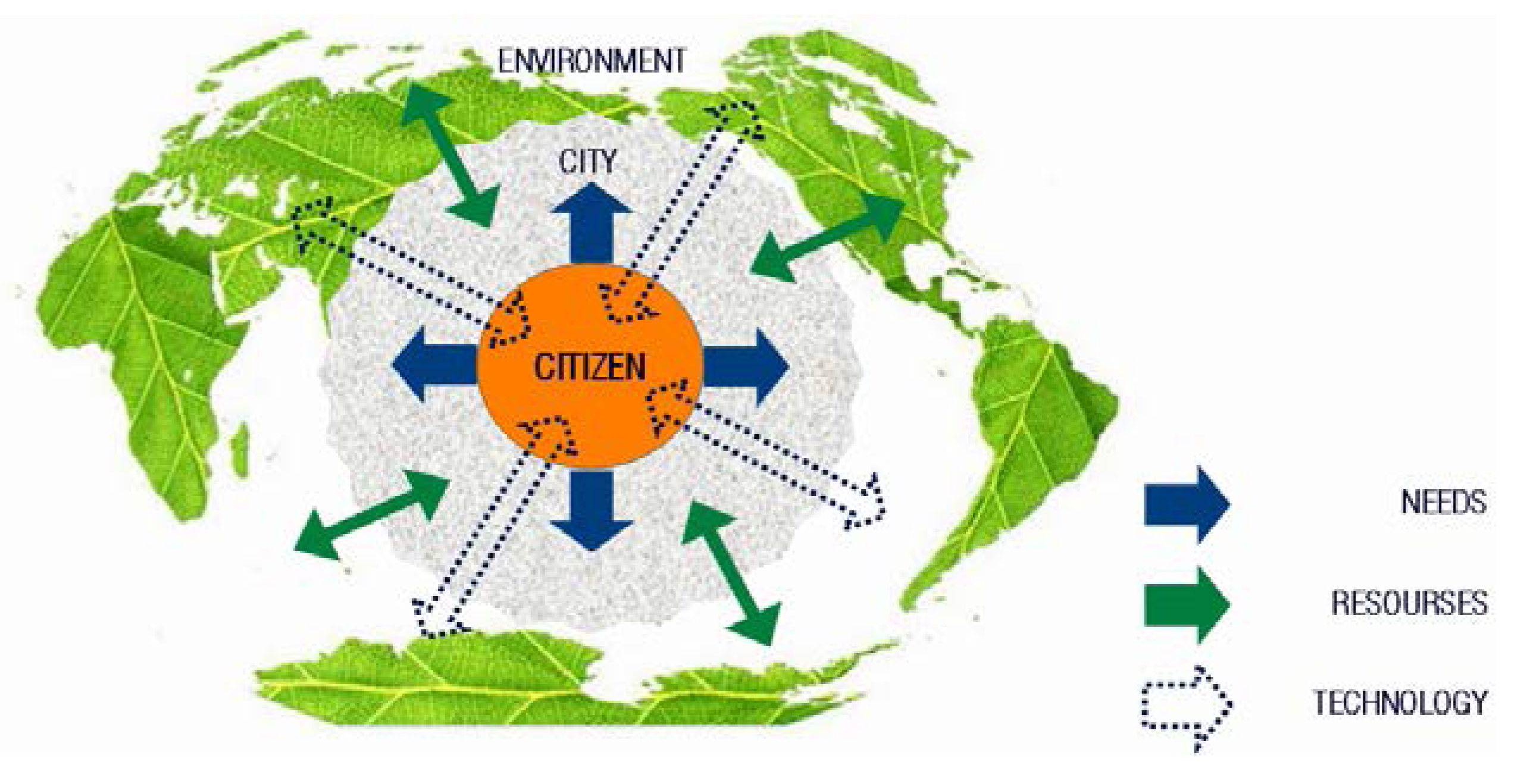1. Introduction
The history of a city cannot be detached from that of its citizens. They are the ones who have determined the city’s location, spatial configuration, growth and development. All of this just has been possible, thanks to a set of technologies, developed and made available by and for the inhabitants themselves. At the same time, Technology is a set of theories and techniques that allow the practical application of knowledge and the completion of certain predefined tasks. Cities have been configured by actions and initiatives -human-driven tasks- and these have been carried out according to the level of development of the different tools and technologies. These tools and technologies have always evolved based on the specific needs of people and urban systems for their economic, commercial, industrial, cultural and personal development. However, the complexity of this technology is determined by two factors: first, available resources, and second, the strength of human initiative exerted in order to accomplish a purpose and take full advantage of the technology.
Now we are facing a new technological revolution, where, perhaps, we are losing the look for a specific purpose, where technology is becoming an end itself, being used before to know clearly why. An obvious exception to this is the case of communication, where people have gained unprecedented availability -to find someone or to be found-, as well as a permanent, hyper-connectivity capability. However, the obsession with being constantly connected and available creates such device dependence that, even being in a communicative action in physical space (the real one), people could prefer nonphysical communication (the virtual) with not present persons. The constant sharing of ideas on the walls, tweets, chats or blogs in social networks allows us to we know what all our friends, followers or admired celebrities are thinking. Urban policies and council’s initiatives are becoming more accessible through the use of smart phones and electronic devices. However, the great reflection today must reside in asking whether the digital communication channels through which all this information flow could become obstacles to the flow of other types currents, or barriers to the development of certain sectors of the population, such as poor neighborhoods, elder people or children. The vast majority of schemes designed so far by Smart City planners have focused more on goods, tools and devices rather than on individuals, who are the final recipients of these services. We should question how the policy of distributing communication services, energy or economic resources to the different sectors of the city and society will be implemented. Urban modeling allows the presentation of different invisible aspects of the city which influence citizens’ behavior and thus the shape of the city’s physical form. Professionals should be able to include different perspectives in their advocacy of urban planning in order to understand different approaches and to look for a common platform of communication [
1].
This is how the need for a tool to evaluate the different technologies and their applications was detected, in order to facilitate the qualification process by city planners as well as by citizens themselves, trying to make easier both the users as the planners the approaching to different technologies an it applicability. Ultimately, how each technological scenario affects city development and citizens?
As mentioned above, today we are facing a brand new revolution of digital systems. This has led to the unprecedented evolution of communication systems, a wide variety of production schemes as well as new forms of leisure and culture. All this has begun to reconfigure the traditional technological scenario. Traditionally, humans developed tools to fulfill a particular need, but nowadays it is the tool that is generating new needs, uncovering new, previously unseen realities for which new solutions and tools must be found. It is a kind of virtuous technology cycle never seen before, in which people are faced with a new way to interact with their environment on a local, regional and global scale. They are becoming “global barbarians,” destroying an ancient empire in order to make way for something new.
The phenomenon of “global barbarism” and its relationship to new technology has been addressed by a number of authors. Baricco [
2] discusses how global barbarians are establishing new relationship channels. Berdyaev [
3] says that technology and the economy follow a hierarchy based solely on utility, with consequent indifference to the truth. Crisso et Odoteo [
4] urgently demand for the arrival of the new barbarian to oppose this new global empire of technology, and Todorov [
5] affirms that while we value the advantages of technology, we are increasingly aware of its side effects. He notes that, although techniques are common to all of us, each culture remains different. The global barbarian phenomenon, which we can see is the driving force behind recent social changes, is not just present in individuals and groups, but also in the decisions of their representatives who, in the act of planning a city (and its use of resources and technologies), are affecting the economic and social development of its inhabitants.
These global barbarians, increasingly involved in informal politics and citizenship, have found new communication channels. They no longer need forums or other physical spaces. Now, from home, their office, from the subway or even while on vacation, they are connected to the world. On one hand they participate in society and the economy but not necessarily in the city or with other citizens physically: they are political citizens, a part of society, but not necessarily part of the urban community. On the other hand it is clear that technology changes behavior, and behaviors change the way of acting in city spaces and places. From the statements made by Augé [
6] in 1992 on ethnography, place is considered both spatial (physical) and relational (people meeting people). However, today we are confronted with a new archetype: the “non-place” that is defined just by the physical space, not so much by the relationships created there. Twenty years later, the digital revolution and, above all, that of multiple forms of communication in virtual environments (P2P-B2P-B2B) have generated a new form of place: one that occurs in the field of virtual reality. Even so, it is a very direct and real relationship, where the user is even more user, even more similar to other users and able to share their comments and opinions instantly. That is, as a whole, the sum of anonymous people, “global barbarians”, forming a network, a social framework whose power lies in the ability to create permanent new places, new relationships and new spaces (which are usually virtual).
Transferring this to the physical environment of urban areas, we know that there are many new exciting, constantly-evolving technologies being made available and affordable for people every day. However, the purpose and benefits of these technologies are not always clear, or whether they are the most efficient and appropriate technologies with which to meet the needs of the city. Urban spaces are changing and expanding their borders. They have been converted and reconfigured into new territory, partly real, partly virtual. As a result, they require a new tool to determine what the most appropriate technology is to fit each particular problem that arises.
2. Results and Discussion
2.1. Main Objectives
Our main goal here is to develop a tool that better serves the needs of modern cities and their inhabitants in the process of deciding how to implement new technologies.
When we discuss the issue of Smart Cities, we are not just talking about technology applied to the city and its spaces, but more importantly its impact on the city’s inhabitants. Therefore, priority must be given to the ends, not the means. For example, if we talk about mobility we are not just talking about car travel or public transport, but rather about people going from one place to another. This must be accomplished in an efficient way, in the shortest amount of time, as comfortable as possible, and with minimum social and environmental impact. In terms of energy, its efficient use and consumption may be the ultimate goal; however, the sources of this energy must also be the most efficient and economical searching for maximum efficiency and lower environmental impact during its production and transport. And if we talk about places and public spaces, the types of relationships that will be created must be considered.
In cities everything is produced by superposition, from reusing buildings and places or by large expansion processes. We must focus on the idea that technology is fundamental, but only if it is oriented towards the specific needs of human beings, That’s why we must recover the original spirit of technological development and its applications: the why and the wherefore.. However, we are not talking about the needs of an ordinary citizen, but rather a network of well-informed citizens with changing needs. They require new solutions and mechanisms in order to get more information and real-time solutions. Considering the potential of these new tools, it can be argued that while technologies (e.g., GPS or remote sensing) may be helpful in producing new spatial data, voluntary activities may be a suitable and “low-cost” method of bringing such data up-to-date while describing it in an informal, more accessible manner to citizens [
7]. Some authors have said that networking is essential for the social organization of the city of the future, using Digital Urban Planning and new technologies in conjunction with the use of Internet as an extraordinary tool for disseminating information among citizens. On the other hand, they recognize that the implementation and monitoring phase of these technologies and unfiltered communication networks have always been the Achilles’ heel of urban planning [
8].
Therefore, we see the need for a tool in the form of a matrix f that can be used to analyze different technologies in terms of their usefulness, their potential uses, their expected results and, above all, their consequences. This matrix should consider the effects of different technologies, as well as the impact of their possible applications in cities. With the help of this matrix we could review the information and communication technologies that are managing and transforming the cities of the 21st century into Smart Cities: analyzing the impact on social behaviors, which ultimately tend to set or configure the spaces, areas, zoning, roads or channels of distribution (e.g., energy, information, economic flows, and social relations), from their production to their points of application, as well as comprehensive management in and between cities. The object of this article then is to summarize the different elements to be considered in new technological cities, in order to establish a matrix that can be used to analyze those different tools and their applications.
2.2. Scope of Application
The natural area of application of this matrix would fit into what we call today “Smart Cities”. Before moving forward, though, it is necessary to define what a Smart City is, especially since there are so many different definitions. A number of experts in this field have defined a Smart City as the following:
- -
“a city that uses information and communications technologies to make its critical infrastructure, its components and public services more interactive, efficient and visible to citizens” [
9];
- -
“a digital platform on which a complex ecosystem of multiple agents (including administrations, companies and citizens) is developed, equipped with sensors and capable of offering, through the processing of all the information acquired by the sensor network, the best services possible at every moment” [
10];
- -
“a city in which Information and Communication Technologies play a role in one or more sectors” [
11];
- -
“investments in human and social capital and traditional (transport) and modern (ICT) communication infrastructure fuel sustainable economic growth and a high quality of life, with a wise management of natural resources, through participatory governance.” [
12];
- -
“a common framework and to highlight the growing importance of Information and Communication Technologies (ICTs), social and environmental capital in profiling the competitiveness of cities” [
13].
As can be seen in this small sample, the definitions are many and varied. This explains why, if we browse the vast majority of smart-city initiatives found online, we can find a great variety of charts and graphs (
Figure 1) describing factors such as relationships, connectivity, sensing elements, interaction, and data centers. However, rarely does the role adopted by citizens or environmental impact appear on these graphs. Here are just a few examples:
Figure 1.
A few schemes of Smart Cities found online, in which people do not appear. (
a) “Smart Cities Big Data Cycle” [
14]; and (
b) “Smart Cities: a System of Systems of Systems” [
15].
Figure 1.
A few schemes of Smart Cities found online, in which people do not appear. (
a) “Smart Cities Big Data Cycle” [
14]; and (
b) “Smart Cities: a System of Systems of Systems” [
15].
Increasingly, publications, companies and initiatives have begun to appear that incorporate people into their schemes of work (
Figure 2). This is a hopeful development. We must see if just as mere users or if they really take into account their needs and how to meet them:
Figure 2.
In recent years, finally the citizen is on these schemes. (
a) “Infrastructures, operations, people” [
16]; and (
b) “Smart Cities need smart citizens” [
17].
Figure 2.
In recent years, finally the citizen is on these schemes. (
a) “Infrastructures, operations, people” [
16]; and (
b) “Smart Cities need smart citizens” [
17].
As can be observed, there are several elements and different criteria in the definition of Smart Cities, as well in the graphic representation of a Smart City. Then, in searching for the definition of a Smart City we need to remember two things first:
What is a city?
- -
From antiquity, a place for exchange, both social and economic;
- -
At present, a system of systems that generates and promotes these relations and trading, but that occurs partly in real environments and partly in virtual spaces.
What is intelligence?
- -
The ability to understand and comprehend, for which it is first necessary to perceive;
- -
The ability to solve problems, based on memory and experience.
Therefore, we can advance a more comprehensive definition of a Smart City as:
“A space for coexistence among people who, based on the available technologies, can thrive and develop, while taking into account economic, social and environmental sustainability.”
These technologies, in order to act intelligently, should have the ability to perceive (via sensors and cameras), store, and process data (using servers and data centres), and solve problems (programming and information for decision-making). This should all be done in an energy-efficient way that serves the people. Also crucial for smart cities is combining the cloud and the sensors, so that the sensing data can be stored or processed. However, it is expected that people must have a certain level of skill in order to understand and use these systems [
18].
